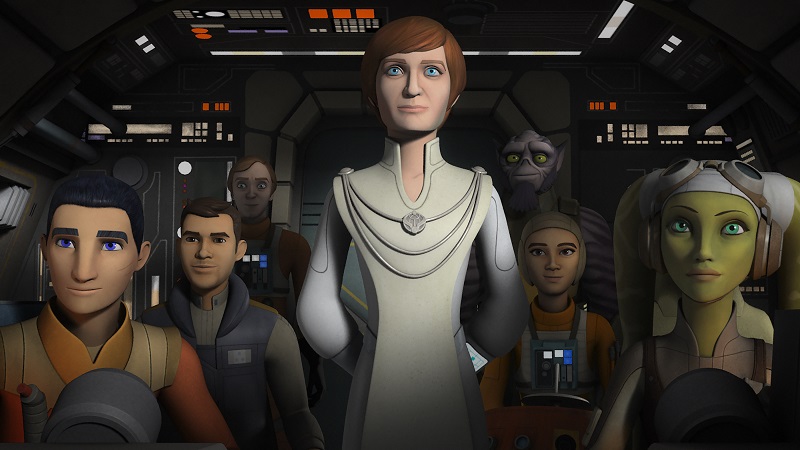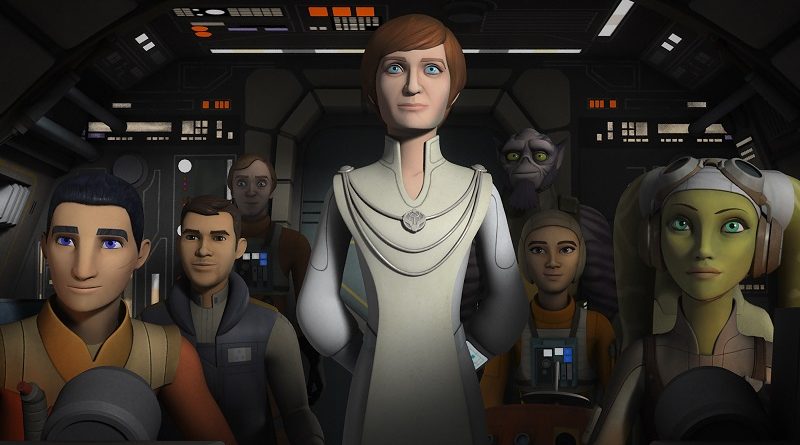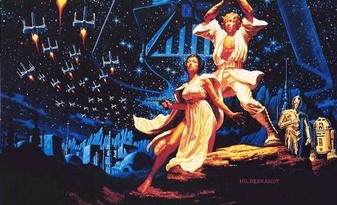Mon Mothma and the Agency of Rebellion
 Tonight’s Star Wars Rebels episode, “Secret Cargo,” finally gave Mon Mothma what the films have not: agency. Character agency is a storytelling term that is frequently misunderstood, but comes up quite often in discussions about female characters. In “Agent of My Own Destiny” I described agency in more detail; in short, a character should make choices that are reasonable to the audience’s understanding, or the storyteller’s yet-to-be-revealed understanding, of that character. This doesn’t mean a character necessarily makes good choices, or that good outcomes will result from the choice. Rather, it requires that the character made a choice, and not simply do something because the plot dictated she should. Agency, though, is not a quality that all characters exhibit. Supporting characters or sidekicks often do not need agency, for example, when the story is being adequately driven by the agency of the principal protagonists and antagonists.
Tonight’s Star Wars Rebels episode, “Secret Cargo,” finally gave Mon Mothma what the films have not: agency. Character agency is a storytelling term that is frequently misunderstood, but comes up quite often in discussions about female characters. In “Agent of My Own Destiny” I described agency in more detail; in short, a character should make choices that are reasonable to the audience’s understanding, or the storyteller’s yet-to-be-revealed understanding, of that character. This doesn’t mean a character necessarily makes good choices, or that good outcomes will result from the choice. Rather, it requires that the character made a choice, and not simply do something because the plot dictated she should. Agency, though, is not a quality that all characters exhibit. Supporting characters or sidekicks often do not need agency, for example, when the story is being adequately driven by the agency of the principal protagonists and antagonists.
In Return of the Jedi, Mon Mothma is a tertiary character who delivers part of a military briefing in advance of a massive impending assault by the Rebel Alliance. That its leader should be present and speak to the assault team is reasonable. What is striking, looking back on Return of the Jedi, is the lack of women shown fighting for an Alliance led by a woman. Several female starfighter pilots were filmed for the Battle of Endor, but ended up on the cutting-room floor.
Though much has changed in Hollywood and Star Wars since the early 1980s, Mon Mothma’s recent appearance in Rogue One: A Star Wars Story fared no better. This is particularly disappointing considering the ongoing efforts of Disney|Lucasfilm to acknowledge the concerns of fans about gender parity in Star Wars, and that one of the intentions of their first standalone film was to highlight the formative moments of the Rebel Alliance. Yet no effort was made to give its leader agency in the film. Her role is again relegated to a tertiary character, with perhaps a few more lines than Return of the Jedi. Despite leading the Alliance she says little during a history-making debate about confronting the looming peril of the Death Star, except to tell Jyn the odds are too great – a line that feels like one of K-2SO’s throwaways. Instead, villainous characters Grand Moff Tarkin and Darth Vader, both already with plenty of agency and character progression in the movies, books, and animated shows, received more storytelling time. Even Admiral Raddus, added to the film only in the reshoots, has the opportunity to make a decision to go to Scarif; Mon Mothma, who was included from the early drafts, gets to learn the news and smile.
In “Secret Cargo,” Mon Mothma finally gets her due as a Rebel Alliance leader who ought to possess agency. Her choice to leave the Senate, and her bold actions to inspire others to resist, are front and center. She reveals regret during her conversation with Hera, and discusses her earlier attempts as a Senator to thwart Palpatine. She even gets to be part of the action, helping to free the Ghost from the stuck airlock. Based on what we know about Mon Mothma, everything she does in this episode reflects relatable and believable moments for a character who is a galactic senator and leads a rebellion against an overwhelmingly oppressive regime masterminded by a Sith.
This season of Star Wars Rebels has been some of the best for female characters regarding agency and characterization. Sabine’s arc highlights one of the tricky parts of assessing agency. Fans often struggled with Sabine’s choices, particularly her unwillingness to take charge in situations that she obviously should have, such as the season opener “Steps Into Shadow,” where she seemed better suited than Ezra to lead the mission to steal Y-wings from Reklam Station. Viewed as a whole, though, the Sabine arc spanning from Season Two’s “The Protector of Concord Dawn” to “Legacy of Mandalore” demonstrates that her decisions are reasonable given her past. In reviewing serial storytelling, whether it is comics, book series, or television shows, actions which might appear to be plot-driven storytelling may be part of the planned storytelling progression.
 Listening to Mon Mothma talk to Hera about her internal struggle in fighting for change resonated for me. Her efforts in the Senate, working within the system, were done with the best of intentions – something we previously had been left to infer as fans and not really know. Three times this season Star Wars Rebels has been able to create a truly visceral moment that related to my experience as a woman, the others being when Sabine trained with Kanan and Sabine’s heart-to-heart with her mother. It is not that I can’t relate to things happening to male characters – Force knows, if you are a longtime Star Wars fangirl you have learned to live the myth through the eyes of men – but rather that true empathy comes from experiencing stories told from all sorts of viewpoints. Even better, Sabine and Ursa Wren’s conversation in “Legacy of Mandalore” and Hera and Mon Mothma’s cockpit soul-bearing in “Secret Cargo” are rare Bechdel Test passing moments in visual Star Wars storytelling.
Listening to Mon Mothma talk to Hera about her internal struggle in fighting for change resonated for me. Her efforts in the Senate, working within the system, were done with the best of intentions – something we previously had been left to infer as fans and not really know. Three times this season Star Wars Rebels has been able to create a truly visceral moment that related to my experience as a woman, the others being when Sabine trained with Kanan and Sabine’s heart-to-heart with her mother. It is not that I can’t relate to things happening to male characters – Force knows, if you are a longtime Star Wars fangirl you have learned to live the myth through the eyes of men – but rather that true empathy comes from experiencing stories told from all sorts of viewpoints. Even better, Sabine and Ursa Wren’s conversation in “Legacy of Mandalore” and Hera and Mon Mothma’s cockpit soul-bearing in “Secret Cargo” are rare Bechdel Test passing moments in visual Star Wars storytelling.
It wasn’t lost on me, either, that Mon Mothma wears a white pantsuit in her animated form. Having listened to Dave Filoni talk about the limitations of rendering large amounts of cloth, likely her attire was trimmed down from the iconic white robe for budgetary reasons. But it’s no coincidence that Mon Mothma wears white, the color chosen by the Congressional Union for Woman Suffrage because it is “the emblem of purity, symboliz[ing] the quality of [their] purpose.”
“Secret Cargo” has three female characters in positions of authority – Mon Mothma, Hera Syndulla, and Governor Pryce – and includes several other female pilots. Gold Two, however, falls victim to the perilous Woman Gets Knocked Unconscious trope in order to move Ezra into a Y-wing. Gold Leader getting a case of the space faints instead might have made Ezra stepping to the action more reasonable, rather than an experienced squadron commander like Jon Vander simply trusting a noobie in a Y-wing. In addition, of the fifteen speaking roles in this episode, only five were written for women, leaving the show right around the film industry average. Imagine the difference in the proportion of lines delivered by women if Mon Mothma’s assistant Erskin also had been female, for example. Despite all the beautiful things that happen in “Secret Cargo” – including the developments for Hera, Ezra, and the overall worldbuilding of Star Wars Rebels – the female characters remain secondary in the context of the show.
- Hyperspace Theories: SKELETON CREW Ahoy! - December 29, 2024
- Hyperspace Theories: WICKED Part I Rises to the Moment - December 6, 2024
- Columbia’s Vader™ Collection Launches Dec 5 - November 27, 2024












Pingback:Episode 4: Princess, General, Huttslayer - kyberclub